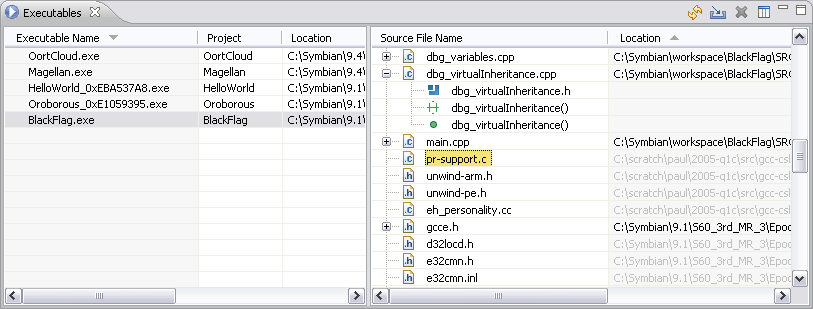Executables view
The  Executables view provides a dynamic list of executables and their related source files. The Executables view makes it easy to:
Executables view provides a dynamic list of executables and their related source files. The Executables view makes it easy to:
- target all binaries for debugging because the symbolics are automatically loaded when a bld.inf is imported or a project is created from a template
- debug a binary that is not part of a project in the workspace by importing it into the Executables view to load the symbolics
- debug a process running on a device by attaching to the process and importing the binaries associated with the process into the Executables view to load the symbolics. For example, you to debug a library loaded by the process, you would need to import the libary and the process executable.
- remove binaries when a project is closed or deleted from the workspace
- remove binaries imported from outside the workspace by deleting the binary from the Executables project in the Project Explorer view
- locate and manage which source and resource files are associated with each executable. Paths shown in black text have been resolved, those in gray text cannot be found.
- identify and correct any path issues with missing source files (shown in gray text). Double-click the missing source file to open a Locate File editor view which enables you to find the missing file.
- view routines and header files used by the source file. Click the tree control to expand or collapse a list of included header files and routine names for fast navigation.
- find and set breakpoints, watchpoints, and eventpoints in source files. Double-click a source file to open it in an editor view and to review the status of its breakpoints.
In addition, an Executables project is created in the Project Explorer view. The binaries shown in the Executables project can be deleted which also removes them from the Executables view. For binaries outside the workspace you must import them into the Executables view so their symbolics can be used during the debug session. You can also drag and drop executables into the view.

The Executables view consists of the Executable Name and Source File Name panes described in the table below. Use the Columns button in the toolbar to show or hide specific columns in each pane. Columns can be sorted and rearranged in the order desired.
| Pane | Explanation |
|---|---|
| Executable Name | Displays a list of executables in the workspace as well as other files added by the user. Select an executable to update the Source File Name pane with related files. The executable information shown can include:
Click the Columns icon ( |
| Source File Name | Displays a list of source files for the selected executable as extracted from the symbol table. The source file information shown can include:
Expand a file's tree control to view the functions and header files used by the file. Double-click to open the source file for editing or to set breakpoints. Click the Columns icon ( |
Executables view toolbar icons
The table below lists the unique icons displayed in the Executables view toolbar.
| Command | Name | Description |
|---|---|---|
Refresh the list of executables |
Click to refresh the executables list. | |
| Import an executable file | Click to import an executable not in the workspace into the executables list. | |
| Remove the selected executables | Click to remove the selected executables from the executables list. | |
| Columns | Opens the Configure Columns dialog for configuring which columns appear in the Executable and Source File panes. |